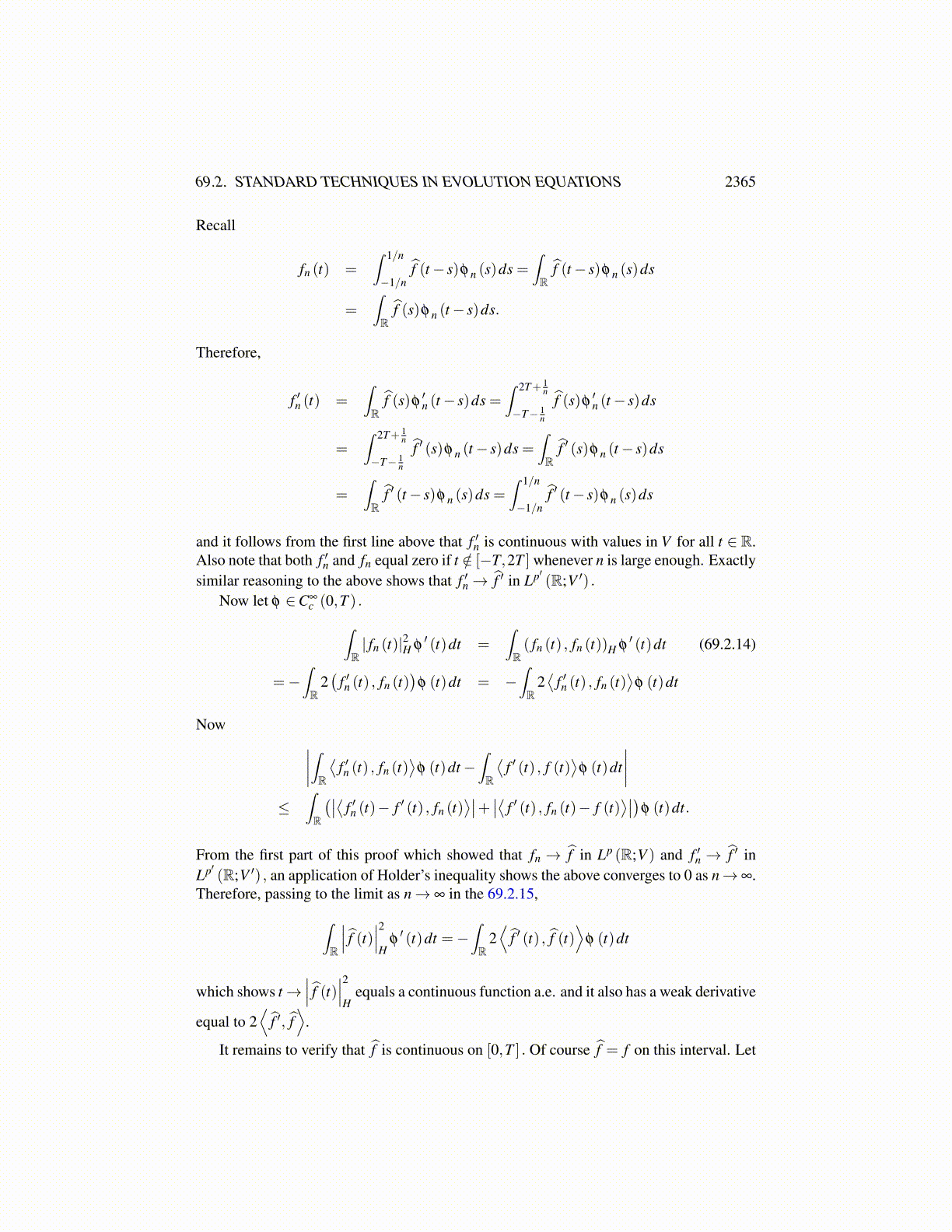
69.2. STANDARD TECHNIQUES IN EVOLUTION EQUATIONS 2365
Let φ ∈C∞c (2a−b,2b−a) . Then from the integration by parts formula,∫ 2b−a
2a−bf (t)φ
′ (t)dt
=∫ b
af (t)φ
′ (t)dt +∫ 2b−a
bf (2b− t)φ
′ (t)dt +∫ a
2a−bf (2a− t)φ
′ (t)dt
=∫ b
af (t)φ
′ (t)dt +∫ b
af (u)φ
′ (2b−u)du+∫ b
af (u)φ
′ (2a−u)du
= f (b)φ (b)− f (a)φ (a)−∫ b
af ′ (t)φ (t)dt− f (b)φ (b)+ f (a)φ (2b−a)
+∫ b
af ′ (u)φ (2b−u)du− f (b)φ (2a−b)
+ f (a)φ (a)+∫ b
af ′ (u)φ (2a−u)du
= −∫ b
af ′ (t)φ (t)dt +
∫ b
af ′ (u)φ (2b−u)du+
∫ b
af ′ (u)φ (2a−u)du
= −∫ b
af ′ (t)φ (t)dt−
∫ 2b−a
b− f ′ (2b− t)φ (t)dt−
∫ a
2a−b− f ′ (2a− t)φ (t)dt
= −∫ 2b−a
2a−bf ′ (t)φ (t)dt
where f ′ (t) is given in 69.2.8.
Definition 69.2.12 Let V be a Banach space and let H be a Hilbert space. (TypicallyH = L2 (Ω)) Suppose V ⊆ H is dense in H meaning that the closure in H of V gives H.Then it is often the case that H is identified with its dual space, and then because of thedensity of V in H, it is possible to write
V ⊆ H = H ′ ⊆V ′
When this is done, H is called a pivot space. Another notation which is often used is ⟨ f ,g⟩to denote f (g) for f ∈V ′ and g ∈V. This may also be written as ⟨ f ,g⟩V ′,V . Another termis that V ⊆ H = H ′ ⊆V ′ is called a Gelfand triple.
The next theorem is an example of a trace theorem. In this theorem, f ∈ Lp (0,T ;V )while f ′ ∈ Lp (0,T ;V ′) . It makes no sense to consider the initial values of f in V becauseit is not even continuous with values in V . However, because of the derivative of f it willturn out that f is continuous with values in a larger space and so it makes sense to considerinitial values of f in this other space. This other space is called a trace space.
Theorem 69.2.13 Let V and H be a Banach space and Hilbert space as described in Def-inition 69.2.12. Suppose f ∈ Lp (0,T ;V ) and f ′ ∈ Lp′ (0,T ;V ′) . Then f is a.e. equal to acontinuous function mapping [0,T ] to H. Furthermore, there exists f (0) ∈ H such that
12| f (t)|2H −
12| f (0)|2H =
∫ t
0
⟨f ′ (s) , f (s)
⟩ds, (69.2.10)